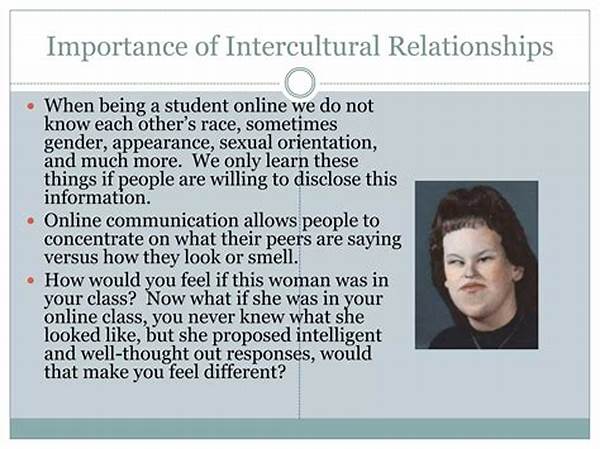The subject of intercultural relationships in literature has been richly explored, serving as a lens through which readers can examine the complexities and dynamics of human connections across cultural boundaries. By delving into stories that transcend geographical and cultural frontiers, literature offers profound insights into societal norms, prejudices, and aspirations. This article aims to dissect the components of intercultural relationships as depicted in literary works, revealing the multifaceted nature of human interactions within diverse cultural contexts.
Read Now : “love Amidst Historical Conflict”
The Historical Evolution of Intercultural Relationships in Literature
Intercultural relationships in literature have traversed various phases of interpretation over the centuries, reflecting the evolving perceptions of society towards culture and diversity. Early literary works often depicted intercultural interactions with a focus on conflict and misunderstanding. As societies progressed, literature began to celebrate the richness of cultural exchanges, portraying more nuanced explorations of intercultural relationships. Such narratives have provided a fertile ground for authors to challenge stereotypes and promote mutual understanding, thereby contributing to a broader discourse on global interconnectedness.
In contemporary literature, intercultural relationships frequently encompass both romantic ties and friendships, highlighting the similarities and differences between diverse cultures. Authors employ these relationships to articulate the challenges and rewards of cross-cultural interactions, emphasizing themes of empathy, acceptance, and resilience. Through meticulously crafted characters and storylines, literature continues to forge pathways for dialogue and reflection, prompting readers to confront their own biases and expand their worldview.
Key Themes in Intercultural Relationships in Literature
1. Identity and Belonging: Intercultural relationships in literature often explore characters’ struggles with identity and the quest for belonging, revealing how cultural backgrounds can both divide and unite individuals.
2. Conflict and Resolution: Many narratives showcase the conflicts that arise from intercultural interactions, ultimately illustrating the potential for resolution through understanding and compromise.
3. Cultural Exchange: Literature highlights the exchange of cultural traditions and ideas, enhancing characters’ understanding and appreciation of diverse customs.
4. Prejudice and Acceptance: Intercultural relationships in literature frequently address themes of prejudice, inspiring narratives of acceptance and growth as characters confront societal biases.
5. Adaptation and Change: Characters in these stories often undergo significant personal transformations, adapting to new cultural environments and developing more inclusive worldviews.
The Representation of Intercultural Relationships in Modern Literature
The representation of intercultural relationships in contemporary literature serves to illuminate the intricate tapestry of human interaction in an increasingly globalized world. Modern authors weave narratives that reflect the complexities of human connection, illustrating both the challenges and triumphs of navigating multicultural landscapes. Through detailed character development and compelling plots, literature provides a mirror to society’s ongoing negotiations with diversity and cultural integration.
Intercultural relationships in literature also serve as vehicles for exploring themes of resilience and the human capacity for empathy. By presenting characters who grapple with cultural dissonance and aspire towards mutual respect, authors spotlight the potential for harmonious coexistence. Such narratives encourage readers to embrace cultural pluralism, offering a hopeful vision of unity amidst diversity.
Detailed Analyses of Intercultural Relationships in Literature
1. Complex Characters: Authors depict intricately developed characters who embody the inner conflicts that arise from cultural differences.
2. Narrative Structure: The structure of these stories often mirrors the fluidity and unpredictability of real-life intercultural relationships.
3. Cultural Nuances: Many works focus on the subtleties of cultural interpretation, revealing the depth and richness of cross-cultural interactions.
4. Historical Contexts: Intercultural relationships are frequently set against historical backdrops, providing context and depth to the narratives.
Read Now : Cross-cultural Romance Historical Context
5. Symbolism and Metaphor: Authors employ symbolism to deepen readers’ understanding of the themes underscoring cultural interaction.
6. Dialogue and Language: Language plays a pivotal role in shaping and reflecting intercultural relationships, enhancing the authenticity of the characters’ voices.
7. Emotional Landscape: Literature captures the emotional intensity underpinning these relationships, from love and joy to frustration and sorrow.
8. Societal Reflection: These works serve as social commentaries, prompting readers to reflect on cultural diversity and its implications.
9. Resolution and Growth: Narratives often conclude with characters reaching a deeper understanding and appreciation of cultural differences.
10. Future Prospects: Literature envisions potential futures influenced by the successful navigation of intercultural relationships.
The Challenges and Opportunities in Intercultural Relationships in Literature
Literature that explores intercultural relationships presents both challenges and opportunities for authors and readers alike. Creating authentic portrayals requires a nuanced understanding of cultural dynamics, necessitating thorough research and sensitivity. The depictions must balance between capturing the rich diversity of cultural experiences and avoiding stereotype perpetuation. Authors face the task of weaving narratives that are engaging yet respectful of cultural intricacies.
On the other hand, these literary works offer an opportunity to foster empathy and cultural literacy among readers. As individuals engage with characters and storylines that reflect diverse cultural experiences, they gain insight into the complexities of intercultural relationships. In this way, literature becomes a powerful tool for education and social change, encouraging a more inclusive and empathetic outlook on global interconnectedness.
Conclusions on Intercultural Relationships in Literature
Intercultural relationships in literature encapsulate the rich tapestry of human experience, offering insights into the complexities and triumphs of cross-cultural interaction. Through well-crafted narratives, literature reflects and influences societal attitudes towards diversity, promoting dialogue and understanding across cultural divides. The exploration of these relationships in literature not only enriches the reader’s comprehension of cultural nuances but also inspires a more nuanced appreciation of the shared human condition.
The enduring appeal of intercultural relationships in literature lies in their capacity to reveal universal themes of love, loss, discovery, and transformation. As society continues to navigate the challenges and rewards of cultural diversity, literature remains an essential forum for exploring these dynamics. By engaging with stories of intercultural interaction, readers are invited to broaden their perspectives, cultivating a deeper empathy and connection with the global community.
